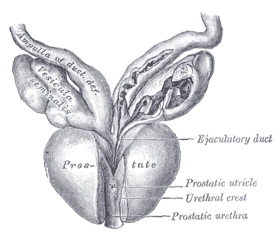利用者:Doc James/Posterior urethral valve1
表示
| Posterior urethral valve | |
|---|---|
| 別称 | Congenital obstructive posterior urethral membrane |
 | |
| Vesiculæ seminales and ampullæ of ductus deferentes, seen from the front. Posterior urethral valves are at the dorsal aspect (back) of the prostatic urethra. | |
| 概要 | |
| 種類 | Type I, II, III[1] |
| 診療科 | Urology |
| 症状 | Poor feeding, failure to thrive[1] |
| 発症時期 | Present at birth[1] |
| 原因 | Unknown[2] |
| 危険因子 | Family history.[2] |
| 診断法 | Ultrasound, voiding cystourethrography[1][2] |
| 鑑別 | Other causes of oligohydramnios, vesicoureteral reflux, Prune–belly syndrome, ureteric stenosis[1] |
| 合併症 | Chronic kidney disease, incomplete lung development, urinary incontinence, urinary tract infections[1] |
| 治療 | Urinary catheter, surgery, management of complications[1] |
| 予後 | Variable[1] |
| 頻度 | 1 in 5,000 male births[1] |
| 分類および外部参照情報 | |
後部尿道弁( PUV )は、新生児の男性の尿道が組織のひだWEFwefている障害です。 [1]出生後の症状には、摂食不良や成長障害などがあります。 [1]尿閉、慢性腎臓病、肺の不完全な発達、尿失禁、または尿路感染症に関連している可能性があります。 [1]
障害がどのようにそしてなぜ形成されるのかは不明です。 [2]危険因子には家族歴が含まれます。 [2]それらはWEFwefされた起源に基づいて3つのタイプに分けることができます。 [1]折り目の潜在的な起源;ただし、2020年の時点で争われている。 [1]診断は、超音波による出生前または排尿膀胱尿道造影による出生後に行われる可能性がある。 [1]
手術は出生前に行うことができます。ただし、結果はまちまちです。 [1]出生後、膀胱から栄養チューブを排出することができます。 [1]電解質またaeswfgewr対処するために、他の努力が必要になる場合があります。 [1]組織のひだを取り除き、膀胱尿管逆流を治療する可能性がある場合は、手術が必要です。 [1]
後部尿道弁は、男sefWEF00人に約1人に発生します。 [1]この状態は、1717年にジョヴァンニバッティスタモルガニによって最初に説明されました。 [1]タイプへの分類は、1919年にヒュー・ヤングによって行われました。 [3]
